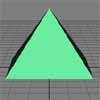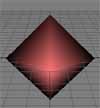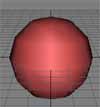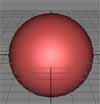ATI TRUFORM Technology - Powering the next generation Radeon
by Matthew Witheiler on May 29, 2001 6:00 AM EST- Posted in
- GPUs
A Bit of Background
In order to understand what TRUFORM technology does for gaming, it is necessary to take a look at how current games are designed and rendered.
3D game scenes, characters, and objects are all created out of triangles meshed together to create polygons. It is easy to understand how simple 3D objects, such as a pyramid, are created out of interacting triangles, with each side one large triangle and the square base a composition of two triangles.

A simple pyramid
Other objects are created in the same manner, with interacting triangles placed together to make other, more complex, shapes as shown below.

3D model of a face
In the case of our pyramid, no more and no less than six triangles need to be used to achieve the desired effect: less than six triangles would not create the pyramid shape (given the 2 base triangles and the 4 triangular sides) and more than six triangles would result in no visual difference. Not so simple geometric structures, on the other hand, can be created with as few or as many polygons as desired with noticeable changes in visual quality.
In the case of the sample sphere above, as few as 8 triangles can be meshed together to create a spherical looking object of sorts (that actually turns out to be two pyramids meeting at the bases). Increasing the triangle count, or segments of the sphere, results in a more realistic looking object, as in the real world our sample sphere can only be approximated correctly with an infinite amount of polygons.
 |
 |
 |
|
4
segment sphere
Triangles are too large to form sphere shape |
12
segment sphere
Note rough edges and poor lighting pattern |
100
segment sphere
Note realistic look to edges and good lighting pattern |
As you can see, increasing the polygon count on the sphere increased it realism, transforming it from the intersecting pyramids created with 8 triangles into the smooth sphere generated with 100 segments.
Naturally, the same attributes that were present in our sphere are also present with more advanced structures, such as a character in a game. When developers and artists get together to create game characters, scenes, objects and more, they must keep a close eye out for how many triangles (or polygons) a scene will consist of. This is because the higher the polygon count in a scene, the more work the video card has to do in order to render, transform, and light the scene. Increased polygon count requires both increased bandwidth to transfer the triangles to the graphics chip and also increased memory for the storage of these triangles. Plus there is the fact that a graphics chip can only process so many triangles per clock cycle.
The artists must strike a balance between the number of triangles used to describe a scene and the amount of visual realism present in it. Once again, ideally an infinite number of triangles would be used to describe a scene, since this would best approximate the real world, however this is impossible. Since games must be designed around the hardware that is running them, and in order to sell a title a game must run on more than just the most powerful system available, most games heavily limit the number of polygons in a scene, like Quake III Arena which averages around 10,000 polygons per scene.
It all boils down to the fact that when it comes to polygon count, the more the merrier but hardware limitations hold artists back. When the strive is to increase image quality in game-play, increased polygon (or triangle) counts seem to be the perfect answer. There is, however, a better one.










3 Comments
View All Comments
Bloodshedder - Wednesday, March 8, 2006 - link
I'd like to know what happened to truform. ATI seems to have removed mentions of it from their site. http://www.ati.com/na/pages/technology/hardware/tr...">http://www.ati.com/na/pages/technology/hardware/tr... is 404.Dr AB - Sunday, May 10, 2020 - link
Wouldn't be surprised if the same technology still exists today ... By some other "fancy" name.pwnedbygary - Tuesday, September 14, 2021 - link
It is, it was re-implemented as Terrascale in modern GPU's.